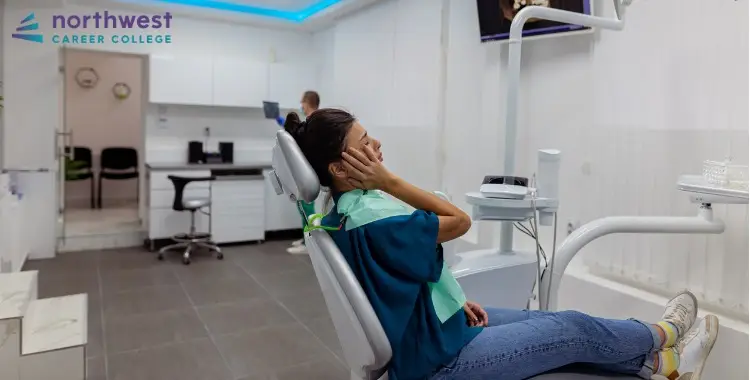Best Practices for Inventory Management for Dental Assistants
- Dental Assistant
- March 12, 2024
- 2.8k views
- 5 min read

Whether you are a dental assistant student who is getting ready to start a new career or an experienced dental assistant who is looking to enhance their skills, inventory management is a topic worth exploring. Inventory costs are something that every dental office in the world worries about, and a dental assistant who is effective at managing inventory will become an invaluable asset to their office.
This article seeks to provide some tips and tricks for how to manage the inventory in your dental office effectively. This will drive profitability for the practice and ultimately help advance your career.
Read More: How to Become a Dental Assistant?
Table of Contents
Establish an effective inventory system
If you already work in an established dental practice, your office may have an effective inventory system. In that case, you should do your best to learn the practices within your office. The old adage goes, “if it ain’t broke, don’t fix it.”
That said, many established dental practices do not have effective inventory systems, and new dental practices certainly do not yet have inventory systems in place. In these circumstances, you can play a pivotal role in creating an inventory system.
A well-organized inventory system Consists of effective inventory lists, a monitoring plan, and a streamlined ordering system. We will review these components in greater depth below, but you must remember the ultimate goal… Bridges to ensure the availability of necessary supplies while minimizing costs and preventing waste.
Create a comprehensive inventory list
An effective inventory system starts with the inventory list. if you do not know the full and complete list of dental supplies used in your office, it will be impossible to manage your office’s inventory effectively.
Start by looking through all disposable supplies and equipment in your office. Each item currently used should be recorded in a spreadsheet or inventory management system. Entries should include the item description, the preferred vendor, the amount on hand, and the expiration date for supplies, as applicable.
As you compile your comprehensive inventory list, it’s a good idea to determine whether certain supplies can be eliminated from the office. This is typically most effective when you have identified that certain items frequently expire before they are used or are not used for extended periods of time.
Establish clear inventory procedures
Once you have a comprehensive inventory list ready, you must determine your plans for monitoring and purchasing inventory.
The first and most important thing you can establish within your inventory procedures is to delegate a specific individual within the office (potentially you) to complete monitoring and purchasing. By holding an individual accountable for these responsibilities, it is more likely to be done effectively and efficiently.
You must also establish a systematic approach to inventory management. This includes identifying when inventory will be counted, what the methodology will be, and what re-order quantities will be observed.
The first two components of an inventory management plan, when and how inventory will be counted, are relatively self-explanatory. Re-order quantities warrant a deeper dive.
The re-order amount is the minimum threshold that triggers you to order additional supplies. This is typically dictated by how quickly you go through a particular supply, how long it takes for that supply to arrive, whether there are any discounts available from purchasing that supply in bulk, and whether your office can reasonably store bulk amounts of the supply in question.
If you are relatively new to an office, you will likely need to rely upon other more seasoned team members to determine your re-order amounts, as they will have insight into usage trends. If you are established within your office, you should have the appropriate insight based on your knowledge of the procedure mix and the quantities of supplies typically used within each procedure. This part of the equation varies from office to office and practitioner to practitioner.
Streamline ordering practices
As mentioned above, analyzing historical usage patterns is an important part of determining the optimal order quantities. Setting par levels or re-order quantities helps you ensure adequate stock without overstocking. Also, consolidating orders for multiple supplies into larger orders from a single vendor can significantly reduce shipping costs. Therefore, it is important to be strategic when placing orders.
Read More: How Can I Succeed as a Dental Assistant?
Implement a first-in, first-out system
Some, but not all, dental supplies expire if unused for a period of time. Arranging supplies so the older items are in the front of each cabinet or drawer ensures that older items are used first and minimizes waste. This is similar to in grocery stores. Clearly label items with expiration dates that are visible when quickly looking through supplies to enhance visibility and ensure timely usage.
Regularly monitor inventory levels
As simple as it seems, conducting regular comprehensive physical inventory checks is fundamental to verifying stock levels and identifying discrepancies. Most offices do not have robust practices for tracking the precise usage of disposable supplies, as they are used in large quantities throughout the day. As a result, you must track stock levels consistently to level set your inventory management spreadsheet or software.
Conclusion
Dental assistants play a vital role in effective inventory management. Inventory management, in turn, is critical in maintaining an organized, inefficient dental practice. Without proper supplies of essential materials, dentists cannot provide patient care effectively. Additionally, this impacts overall patient satisfaction within the dental practice.
Not only does inventory management impact patient care, but it also directly impacts practice profitability. By managing inventory, effectively minimizing costs, and reducing waste by implementing the best practices recommended above, dental assistants can significantly contribute to the operational success of their practice.





